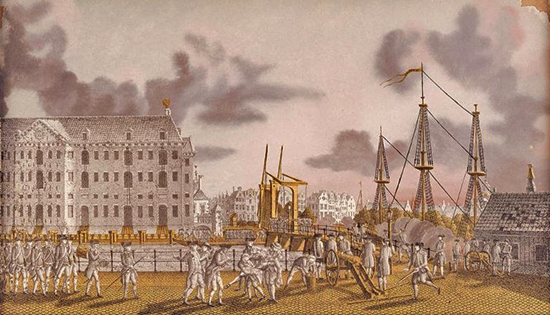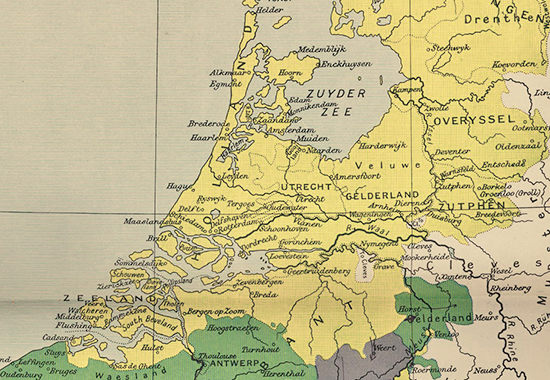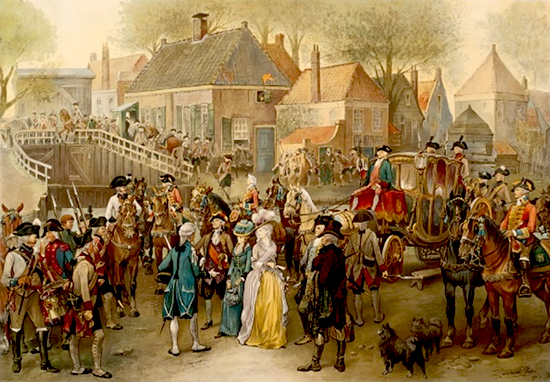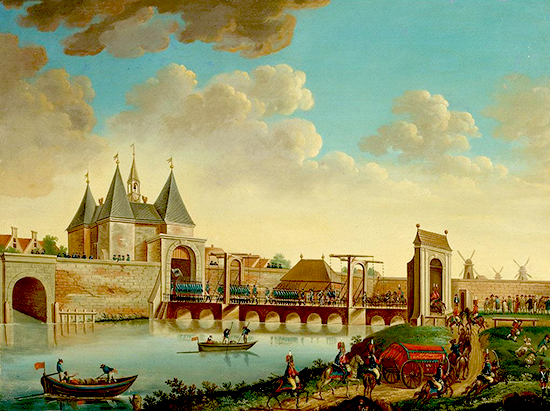|

Battle of the Kattenburgerbrug, Amsterdam — May
30, 1787
Painting by Jonas Zeuner. Amsterdam Museum
Dutch Patriots' Revolt 1787
The Dutch Patriots Revolt was a Dutch civil war.
|
|
It is also called the
Dutch
Patriot Revolt (singular) or more delicately referred to as the Dutch
Crisis of 1787.
Who Fought?
The Patriots
vs.
The Orangists
Who Were the Patriots?
Before and during the French
Revolution, the Patriotten (Dutch for Patriots) were
supporters of the Patriot Party who were in favor of democratic
reforms and against the ruling Prince of Orange.
Among them were,
Joan Derk (Derck / Derk) van der Capellen tot den Pol,
Herman Willem Daendels,
who after losing this revolt went into exile in Dunkirchen, France,
and later joined the French Revolutionary Army.
Rutger Jan Schimmelpenninck
|

Tom Brady, New England
Patriots,
Totally Unrelated and Nothing to Do With the Subject
Who were the Orangists?
Supporters of
 William V (Willem V), Prince of
Orange, and stadtholder, or Stadhouder, of the Dutch Republic
(the United Provinces, the Netherlands), and everything he stood
for.
William V (Willem V), Prince of
Orange, and stadtholder, or Stadhouder, of the Dutch Republic
(the United Provinces, the Netherlands), and everything he stood
for.
On Whose Side Was the
General Public?
From among the Dutch populace, the most
supporters for the Patriots came from the city's middle classes. The lower classes
preferred William V, while the people in the country remained calm and
collected.
The Orangists were strong in the
provinces of Gelderland and Utrecht, the Patriots were strong in the
province of Holland and in the city of Utrecht.
Here is Holland, Gelderland, and
Utrecht on a map:

Map of Holland, Utrecht, Gelderland Provinces
Click to enlarge
Who Won? Who Lost?
William V and his supporters had the revolt under control in
October 1787, but only thanks to help from Prussia.
In a nutshell, it had come to this as
follows:
Back in 1785,
Willem V and his wife Wilhelmina of Prussia (Wilhelmine von Preussen) fled the Patriots,
left The Hague, province of Holland, and moved to Nijmegen, province
of Gelderland.
Willem's supporters wanted him back at
The Hague, but gun-shy Willem said that this would only be an option
if he was invited there.
Wilhelmina was a different breed
entirely. Effectively combining brains with guts, she banked on
backup from her brother, who had just recently become
 Frederick
William II, King of Prussia. So she designed
to provoke the Patriots into an incident that would justify a
Prussian intervention. Frederick
William II, King of Prussia. So she designed
to provoke the Patriots into an incident that would justify a
Prussian intervention.
And it worked.
Wilhelmina announced her return from
Nijmegen to The Hague. She was arrested at the province border. Prussia took
this as an excuse to get involved.

The Arrest of Wilhelmina of Prussia
at the
Goejanverwelle Lock on June 28, 1787
J.J.R. De Wetstein Pfister, Nederlandsche Schoolplaten.
Excellent picture, but maybe untrue. Wilhelmina and her entourage
might have been arrested about three miles further south.
 Read article here, or
Read article here, or
 this one here.
this one here.
However, the main point to remember is that Prussian troops were
sent in support of the Orangists.
The Dutch Patriots, on the other hand, were sure of French
support, but the French had their own problems and handled the
Dutch Crisis rather poorly.
(See also
 Timeline of the French
Revolution)
Timeline of the French
Revolution)
Amsterdam was a Patriot stronghold and
therefore a good destination for the Prussian troops.
On October 1, 1787, an armistice between the
Patriots at Amsterdam and the Prussians had been concluded. On October 10, 1787, and seeing that the
French support didn't materialize, the Amsterdam Patriots gave up.

Prussian Troops Enter Amsterdam at the
Leidsepoort - October 10, 1787
I.M.P.
Amsterdam Museum
Most of the Patriots went into exile
and William and Wilhelmina returned to The
Hague.
The Patriots' Revolt was contained for
the moment. However...
French support eventually did
show up. In January 1795, the Patriots deposed Prince William V
of Orange and installed the
 Batavian Republic (Bataafse
Republiek).
Batavian Republic (Bataafse
Republiek).
The Dutch celebrated for about two
minutes when they realized that their independence had disappeared
and the French were now calling the shots.
Battles of the Dutch Patriots' Revolt
of 1787
Battle of Vreeswijk
near Utrecht — May
9, 1787 — Victory for the Patriots
Battle of the Kattenburgerbrug
Amsterdam — May 30, 1787 — Victory for the Orangists
More History
|